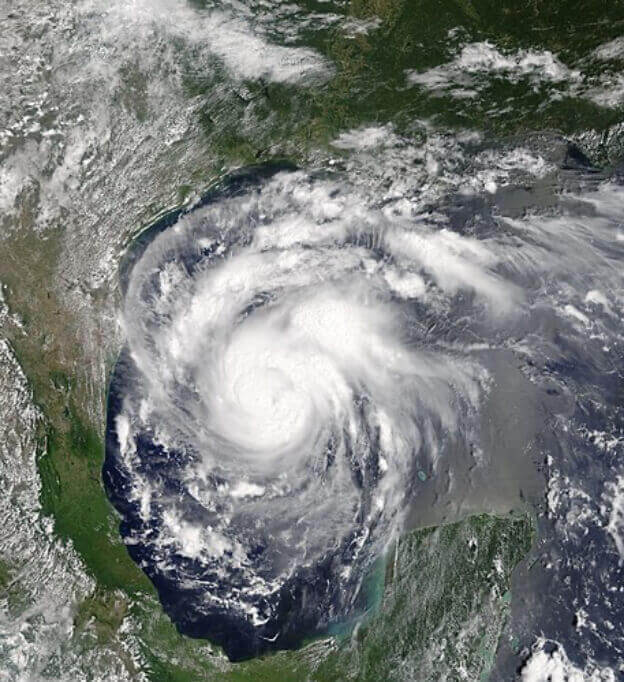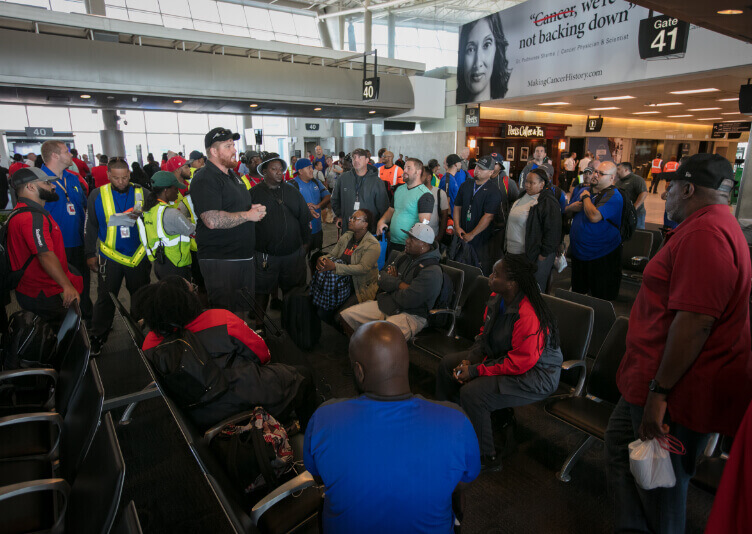
Hurricane Harvey’s meandering path along the Gulf Coast made for historic flooding conditions.
After the Storm: The Hurricane Harvey Rescue Mission
More than anything else, air travelers need to know—with absolute certainty—they are flying on an airline that prioritizes safety and genuinely cares about them. That’s always been one of Chairman and CEO Gary Kelly’s guiding philosophies and chief directives to the People of Southwest Airlines: Show Customers that you care.
On every flight. In every possible situation. No matter the circumstances. Whether it’s a minor headache or a crisis: Prove that you care.
Case in point: Hurricane Harvey, which made its U.S. landfall on Friday, August 25, 2017. It temporarily receded back over water and then surged forward the following day across Southeast Texas and beyond.
The storm, which would become the wettest tropical cyclone ever to strike the contiguous United States, seemed poised to swamp the city of Houston. Records indicate that, in some areas, the storm dumped nine inches of rain in 90 minutes, all of which was whipped into blinding fury by 130-mph winds. Trees were uprooted, big rigs teetered in the wind, and in some cases, winds peeled brick facades clean off the sides of once-sturdy buildings. With Houston’s Hobby Airport cradled in a low-lying area of the city near Sims Bayou, the risk of operational disruptions began to rise dramatically as Friday transitioned into Saturday.
“Being able to plan in good times for things that are going to happen in bad times is something we take very seriously and take great pride in . . . , ” says Senior Director Preparedness and Risk Management Karie Lardon. “It is our responsibility to have a good plan in place.”
Developing comprehensive preparedness plans not only protects Customers and Employees during times of danger, it reinforces the Company’s hard-earned reputation for being one of the most-trustworthy organizations operating today.
These general playbooks are used to swiftly react to an array of different crises, from natural disasters to unexpected health emergencies such as COVID-19. In terms of hurricane activity, the process is broken up into various phases.
During phase one, a small group in Network Operations Control, including an Emergency Director, monitors the storm and relays real-time data to other members of the Company, including the Southwest Weather Disruption Task Force. Phase two focuses on preparing all of the appropriate procedures and checklists needed to ensure all Southwest Employees understand their responsibilities. Should a storm make landfall, Southwest executes its plan, modifying it as needed. The cycle culminates with phase four, which seeks to bring operations back to normal as quickly and efficiently as the circumstances allow.
In the case of Hurricane Harvey, the Southwest Weather Disruption Task Force had been carefully tracking the storm for some time and chose to proactively cancel weekend flights and evacuate as many Employees, Customers, and planes from Houston’s Hobby Airport as possible. Nevertheless, Harvey’s stutter-step course and its extraordinary speed managed to catch even skilled weather trackers by surprise. On Saturday, the streaking storm dumped torrential rains on Hobby, stranding approximately 500 Southwest Customers and Employees, as well as 15 Southwest planes, at the airport.
“While the already-reduced flight schedule was running well, we got so much rain in a short period of time that the runoff could not handle it,” says Senior Director Network Operations Control Steve West.“Once we couldn’t operate safely, that’s when we had to shut the operation down.”
As expected, People at the Headquarters Emergency Command Center in Dallas were intensely focused on devising a rescue plan. “I’ve seen this many, many, many times when we get into a crisis or disaster situation,” says Senior Vice President & Chief Communications Officer Linda Rutherford. “First and foremost: Is everybody safe? What do we need to do to make everybody safe? And then it’s ‘Okay, let’s assess what’s happened. Let’s figure out what we need to do to get people to safety.’”
Unfortunately, Hobby was running out of options—and time. Soon, all the roads leading to and from the airport would likely be closed and the runways submerged, forcing Employees and Customers to remain at Hobby until midweek. There were logistical hurdles as well. Hobby’s runways were technically closed and its control tower abandoned. To attempt any kind of rescue flight, Southwest would need to reach out to the Federal Aviation Administration (FAA) to authorize a special pick-up.

Southwest Airlines prepares to relaunch operations at Houston Hobby.
As the rescue plan was being ironed out, Southwest Employees at Hobby did all they could to assuage fears and provide stranded Customers with simple comforts. In fact, waylaid Passengers described the demeanor of Southwest Employees as being downright “cheerful” as they passed out snacks, soda, and water from the holds of grounded planes. Show them you care. That was the simple playbook Southwest Employees followed Saturday into Sunday morning, as they handed out everything from donuts and coffee to makeshift lunches.
Much of their confidence stemmed from the knowledge that legions of Southwest volunteers always step up during times of extreme duress. This time was no different. Southwest Pilots and Crews located in Houston or at hotels near Hobby had already volunteered to fly evacuation flights whenever they received the go-ahead from the FAA.
On Sunday, the FAA agreed to the proposed rescue on one condition: Hobby’s runway lights were no longer operational, so Southwest had to find a way to fly out before nightfall that evening.
Returning to their weather maps, Southwest Meteorologists at the Emergency Command Center foresaw a potential break in the storm bands that afternoon. All operations were go. Southwest seized on the opportunity, loading up five of its planes at Hobby with Passengers, including crewmembers from other airlines, and flying them to Dallas.
“It happened so fast,” said one of the rescued Customers. “It only took about an hour to an hour and a half before we were on the plane ready to go.”
Knowing there was a host of other problems to face—none more pressing than the shortage of lifesaving medical supplies and equipment created by the flooding—Southwest and its Employees turned their attention to meeting humanitarian needs. Houston (Hobby) Ramp Agent Troy, for instance, managed to procure $10,000 worth of medical supplies and organize a mobile clinic despite having lost his own home. Meanwhile Southwest made a $500,000 contribution to the Red Cross, while ensuring its disaster-relief Partners were provided additional resources to fulfill their missions.
Through it all, Southwest remained equally focused on aiding the roughly 4,000 Southwest Employees living in the greater Houston area. It held fast to one of its bedrock philosophies. At Southwest, our People will always be our most valuable assets.
The Southwest Employee Catastrophic Assistance Charity, which was launched in the 1990s with seed money from Founder Herb Kelleher and President Emeritus Colleen Barrett and continues to be funded by Employee donations, was created for situations just like this.
Although initial one-time grants from the fund were quickly dispensed, more financial support was clearly needed—and needed fast. Knowing that raising additional funds via traditional payroll deductions wouldn’t provide aid quickly enough, Southwest tried something it had never done in its history. It devised, organized, and broadcast its first-ever Southwest telethon.
Training rooms at Southwest Headquarters in Dallas were transformed into telethon call centers. Employees volunteered to answer phones and conduct live interviews with Southwest Leaders during the event, all of which would be broadcast via Facebook Live. When all those variables were ironed out—in merely eight days—the telethon officially went live.
In Linda’s words, the telethon proved to be, “a smashing success,” raising $1.4 million in just 24 hours. The funds not only supported victims of Harvey but those impacted by two hurricanes that followed Harvey—Irma along the Atlantic Coast and Maria in Puerto Rico. All told, Southwest conducted 68 different evacuation and humanitarian rescue flights during what is widely considered one of the most devastating hurricane seasons in recent memory.
“Southwest as a Company does these things because it’s the right thing to do,” says Karie. “There’s nothing that mandates, or tells you, ‘you have to do these things.’ It’s just the right thing to do.”
